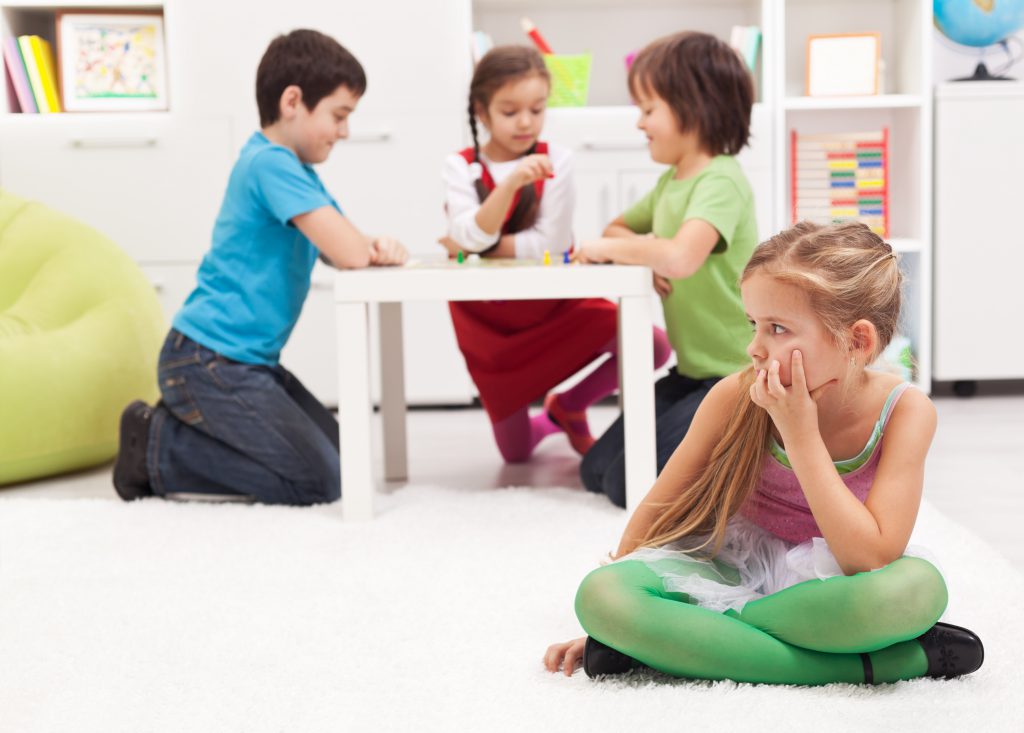Withdrawn Children Show Predictable Brain Activity During Social Interactions

A study using functional MRI brain scans reveals certain areas of the brain have higher activity in children who are socially withdrawn or reticent compared to children who are not withdrawn. In the study, published in Psychological Science, researchers recorded children’s brain activity as they played the role of a new student interacting with peers in a virtual classroom.
The findings provide insight into the brain activity of socially withdrawn children and could inform interventions that teach children how to think differently about social interactions and thus prevent further socially withdrawn behavior or social anxiety.
Social reticence is expressed as shy, anxiously avoidant behavior in early childhood. Some mental health professionals believe that social reticence in childhood and pre-teen years is a precursor to more socially withdrawn behavior and social anxiety that develops through the teen years and adulthood.
Psychological scientist Johanna Jarcho of Stony Brook University and colleagues evaluated 53 children using fMRI. The children were part of a study that began at 2 years of age, with follow-ups over time to age 11. Thirty of the children were evaluated as functioning with high social reticence; 23 were considered to have low social reticence.
The research team created a novel interactive paradigm around a virtual cartoon-based classroom. The 11-year-old children created avatar to represent themselves and completed an online personality profile. The children were told they would be interacting with same-aged peers — in reality, the experimenters had programmed these “peers” according to particular types, such as the “unpredictable kid,” “bully,” or “nice student.” While undergoing fMRI, social interactions inside the classroom were played out, with each child reacting to these social interactions via their avatar.
“Few techniques have been able to test the effects of such nuanced social landscape on brain function during real-time, ongoing, peer-based interactions where peers embody distinct social qualities,” said Jarcho. “This paradigm proved very effective in mapping brain activity of pre-teens who are socially reticent and appears to be a valuable tool for ongoing research.”
The scanning revealed that high (but not low) social reticence was associated with relatively greater activity in the dorsal anterior cingulate cortex and left and right insula, brain regions implicated in processing salience and distress. High social reticence was also associated with negative functional connectivity between insula and ventromedial prefrontal cortex, a region commonly implicated in affect regulation. Also, participants with high social reticence showed increased amygdala activity, but only during feedback from the “unpredictable” peers in the cartoon classroom.
The findings provide scientists with a measure of brain functioning of pre-teens with high social reticence. A critical next step is to isolate neural circuits that promote risk for or resilience against expressions of psychopathology related to high social reticence.
The researchers are currently conducting interviews with the same group of 53 participants who are now approaching their teens. The idea is to determine if the pattern of brain function that differentiated pre-teens with high and low childhood social reticence also predicts expression of social anxiety symptoms.
Co-authors on the paper include scientists from Stony Brook University, the University of Maryland, the National Institute of Mental Health, University of Illinois, University of Haifa, University of Waterloo, Nationwide Children’s Hospital in Ohio, and Ohio State University.
This work was supported by the Intramural Research Program at the National Institute of Mental Health (to D. S. Pine), by the National Alliance for Research in Schizophrenia and Affective Disorders (NARSAD) Young Investigator Award: Ellen Schapiro & Gerald Axelbaum Investigator (to J. M. Jarcho), by the Richard J. Wyatt Memorial Fellowship Award for Translational Research (to J. M. Jarcho), and by grants from the National Institute of Child Health and Human Development (R37HD17899) and National Institute of Mental Health (R01MH093349; both to N. A. Fox).





Comments
So, are the findings of this study going to be used in the understanding and possible treatment of social anxiety/phobia in young people or is this also going to be used in an attempt to “dewire” and demonize natural introversion as well?
APS regularly opens certain online articles for discussion on our website. Effective February 2021, you must be a logged-in APS member to post comments. By posting a comment, you agree to our Community Guidelines and the display of your profile information, including your name and affiliation. Any opinions, findings, conclusions, or recommendations present in article comments are those of the writers and do not necessarily reflect the views of APS or the article’s author. For more information, please see our Community Guidelines.
Please login with your APS account to comment.